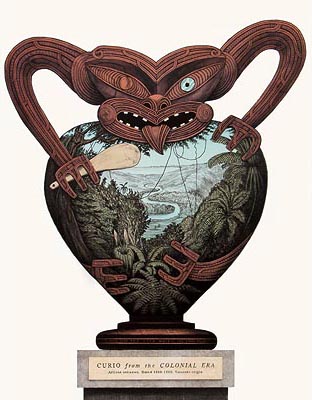
'The protagonist of Marian Maguire’s new print series, Titokowaru’s Dilemma,
is an impressive figure who embodies the complexities and
contradictions of nineteenth-century New Zealand history. Tītokowaru was
a trained Māori tohunga but a Christian convert; an advocate of peace
but an outstanding military strategist; a powerful and charismatic
leader but one who lost the support of his followers. Rather than simply
confusing us, these diverse characteristics offer a more nuanced
understanding of Tītokowaru than we might have of more conventional
early New Zealanders. And it was this that made him an absorbing subject
for Maguire, whose prints exploring colonial history challenge
simplistic readings of the past.
Living in the Taranaki district,
Tītokowaru was involved in battles against the British in the early
1860s, but then led a number of important initiatives promoting peace
with settlers. When continuing land confiscations pushed Māori into war
to avoid starvation, he first resorted to plunder without bloodshed
then, in a situation of escalating conflict, deployed an effective
combination of fear-provoking propaganda, clever field-engineering and
guerrilla tactics to overcome British troops far superior in number to
his own. The unexpected dissolution of Tītokowaru’s army in 1869 after a
series of victories, reputedly because he undermined his mana by
sleeping with the wife of an ally, did not diminish his reputation among
settlers as a formidable opponent, and an uneasy peace was maintained.
Further land deprivations led to a campaign of passive resistance in
which Tītokowaru took part alongside Te Whiti and Tohu. Resistance was
finally quashed in a massive show of force by the British at Parihaka in
1881, which decimated Māori power in the area and saw Tītokowaru
imprisoned a number of times before his death in 1888.
In these
prints, Maguire continues to develop her distinctive imagery drawn from
ancient and colonial sources. The bold silhouettes of Greek vase
paintings are particularly evident in her black-and-white etchings, such
as those depicting amorous adventures involving Greek gods, Māori
maidens, satyrs and settlers, in a series entitled Colonial Encounters. In the large colour lithographs of Titokowaru’s Dilemma,
figures of similar style and clarity are set into New Zealand
landscapes based on colonial paintings and photographs. In Maguire’s
intriguing cultural crossovers, we find such unexpected meetings as
Socrates in discussion with Tītokowaru, Persephone keeping company with
Hine-nui-te-pō in the underworld, and Zeus stalking Papa in a Whangarei
landscape. Figures are transposed into unexpected historical settings,
with Gustavus von Tempsky dying on the battlefields of Troy, Venus de
Milo taken captive in a Māori pā, and the Christchurch statue of Captain
Cook entangled in rata roots in the Taranaki bush. Such intriguing
visual inventions continually surprise and delight us, and tease our
imaginations with human connections across time.
Presenting
Tītokowaru more as a thinking man than a fighter, Maguire frames his
story in terms of the kind of questions that Socrates asked – we
discover him debating ‘what is virtue?’ with Socrates, or discussing
‘what is peace?’ with his compatriot Te Whiti. The fact that, though
pictured against Mount Taranaki, these paired figures mimic the pose of
Achilles and Ajax from a famous black-figure vase by the Greek potter
and painter Exekias, forges links between New Zealand and ancient
Greece, showing that these debates have a timeless significance. In A Taranaki Dialogue,
the enquiry continues in a series of small etchings of the Taranaki
landscape, finally focusing on two questions that seem to underpin
Maguire’s project as a whole: it is she, as much as Socrates or
Tītokowaru, who asks us, ‘what is myth?’ and ‘what is history?’. '
Elizabeth Rankin
(Art History Professor Elizabeth Rankin has written several extended essays and articles about Marian Maguire's work.)